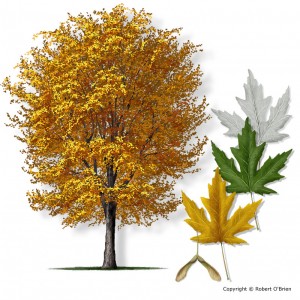
(Also known as river maple, white maple, water maple, or silverleaf maple). This is a medium-sized tree, mostly 60′ to 80′ in height, dividing near the ground into several stout, erect, divergent branches, forming a wide-spreading, rounded crown. Roots are shallow and frequently very near the surface of the soil. Leaves are opposite, simple, deciduous, with 5 lobes and coarsely serrate margins. The flowers appear before the leaves in dense, sessile, axillary clusters on the previous year’s twigs. The corolla is absent, and the stamens are in clusters of 3 to 7, with red anthers. The fruit is a wrinkled, reddish-brown double samara with divergent wings (1 to 2 long), ripening in the spring. At first, the bark is thin, smooth and silvery; at maturity, it breaks into long, loose scaly plates.
Silver Maple is native to eastern North America and is one of the most common trees in the U.S. It thrives in rich, moist bottom-land sites, but is capable of developing on dry soils. It is widely planted as an ornamental shade tree, but its brittle branches can be severely damaged by sleet, heavy snows, and high winds.